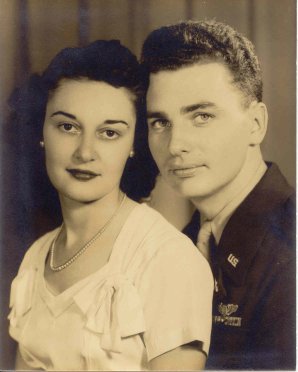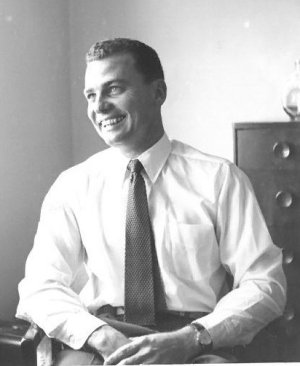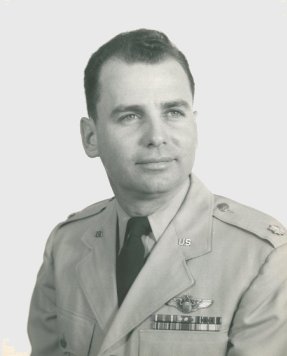
Billy's journal fades out in September of 1944, but his military service did not end then, nor even with the conclusion of World War II in August of 1945.

Billy & June on their first anniversary, 1946
Although we don't have a narrative in Billy's own words to anchor the story of his life after the war, we do have scans of many papers and photos. And, for some of the periods we also have his letters, many of which provide details about his activities. By piecing together information from these various sources, I have tried to tell this post-war story.
This page provides a brief summary of these fifteen years; for more details of his life during the different periods, click on the navigation tabs above. To see more photos, including larger images of some of the photos on these webpages, see this Flickr collection.
Billy's direct involvement in the war ended with his return to the U.S. in late 1944, although of course the war continued in Europe until May of the next year, and in the Pacific for three months longer. However, as both his fate in 1960, and that of his friend Waley Garrett, demonstrate, one does not need to see combat to make the supreme sacrifice for one's country.
While Billy was assigned to pilot training in Brady, Texas, in the spring of 1945, he and June were married there in April. At this point it was possible that experienced airmen might still be needed in the Pacific.
Fortunately, Billy wasn't sent there, but rather spent the first year of his marriage moving from place to place, attending various phases of training, while the war mercifully came to an end.
Billy was officially de-mobilized at Camp Shelby, Mississippi, and returned to his interrupted college studies in the summer of 1946. He remained in the Army—and later, the Air Force—reserves, attending meetings and accumulating paperwork, much of which June kept and we have scanned.
When the Korean War began in 1950, Billy answered his nation's call once again and returned to active duty. He would remain in the service—although not without some thoughts of returning to academia—for the rest of his life.
Much to his disappointment, he was made an instructor upon re-enlistment, rather than a combat pilot, and did not participate directly in the war. But the early 1950's were nontheless an exciting time in his life and career.
From mid-1953 until the end of 1954, he was stationed in Newfoundland with the Northeast Air Command. Since June did not accompany him on this assignment, we have letters and other writings that he sent to her, as well as many photos and slides (both official military photos and pictures that Billy took himself), and of course various orders and other documents from this period.
 Billy in Newfoundland
Billy in NewfoundlandSince there is more documentation of this eighteen-month tour of duty than any other part of Billy's postwar experience, it makes up the largest section of the Postwar Postscript, which I have named "Arctic Sojourn."
Although he missed his family dreadfully, and he came very close to leaving the Air Force after the Newfoundland tour (both of these observations are easily gleaned from his correspondence), this assignment provided exciting opportunities for travel and service in the tense atmosphere of the Cold War.
He was able to see much of Newfoundland's island, as well as making job-related trips to the far arctic of northern Greenland and to Arctic Survival School in Labrador. On one trip to Greenland in the summer of 1953, he visited the site of "Mint Julep," a curiously-named investigation of the properties of the ice cap, to determine if constructions of airbases there would be feasible. We have several letters Billy wrote to June in 1954, but unfortunately only a few from 1953. We are sure many letters must be lost, going by the frequency with which he wrote in the last months of his time in Canada. However, we are most fortunate to have an extensive write-up about the trip to Mint Julep and on to Thule, Greenland. Another, less detailed report of another trip to Greenland for "Exercise Windchill" is also among the letters.
The orders and other official documents for Billy's time in Newfoundland are somewhat disappointing, in terms of letting us know what he did during this period. Too many of them deal with inexplicably obtuse administrative details like specialty codes and service commitments (although the later issue was no doubt of great importance at this potential turning-point in Billy's career).
But at least this major trip—to Mint Julep and Thule—is filled out nicely for us, as are a few other excursions. Thanks to these letters, and some substantive documents, we can construct something of a Newfoundland timeline.
 Billy at Malmstrom, 1960
Billy at Malmstrom, 1960After returning to the U.S., Billy's next major assignment (after a training stint in Georgia) was his last: the Fighter Interceptor Squadron housed at what became Malmstrom Air Force Base in Great Falls, Montana. The base is known today as a major Strategic Air Command site, home to a cluster of nuclear missile silos, but it has played various roles in U.S. military history since its founding in 1939. When Billy was there, its major focus was fighters.
He did a lot of work in his almost five years at Malmstrom, primarily administrative/operations and educational/training tasks. The official documents we have delineate much of this work, including many trips he made to various air bases around the country to learn, teach, and consult regarding all kinds of defense projects.
For part of his time in Great Falls, Billy served as a liaison with the Montana Air National Guard unit based at the Great Falls International Airport. We have assumed that the reason we were able to stay in this lovely city for so long is that Billy actually was transferred, but his new assignment just happened to be in the same town.
To see pictures from Billy's family life in Great Falls, see this section of my "'50's Childhood Digital Photo Album." This page in the Postscript gives information about the fatal crash that took Billy from us in April of 1960.
The originals of the photos, slides, papers and letters, have been donated to the Air National Guard historical office, the Air Force Historical Research Agency, or the museum at Malmstrom. We visited Malmstrom in 2014 to make our donations in person.